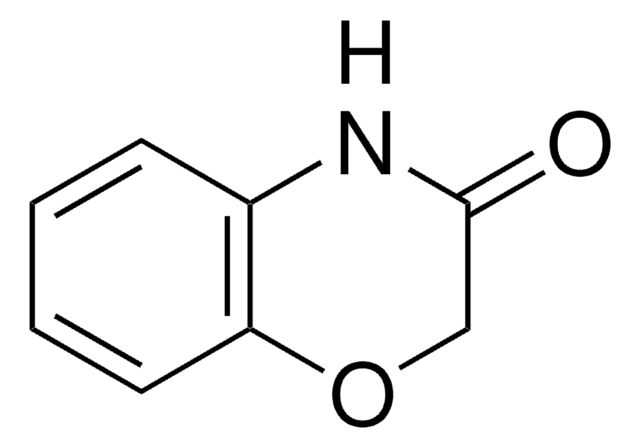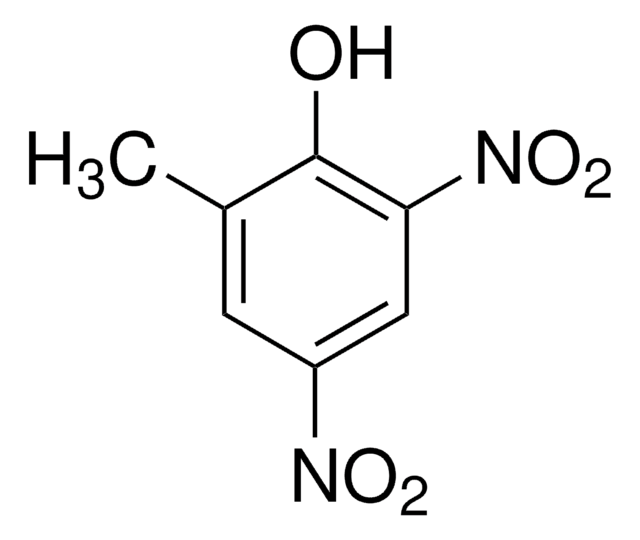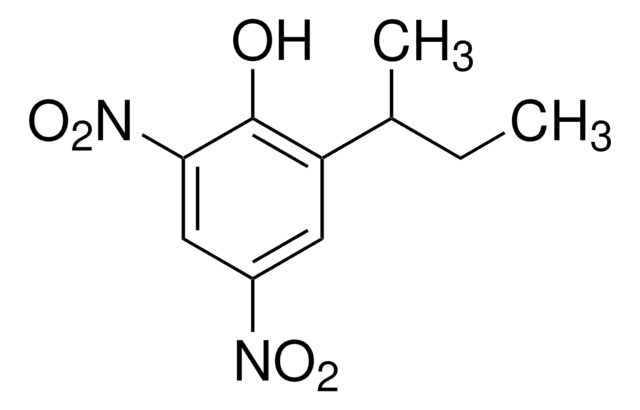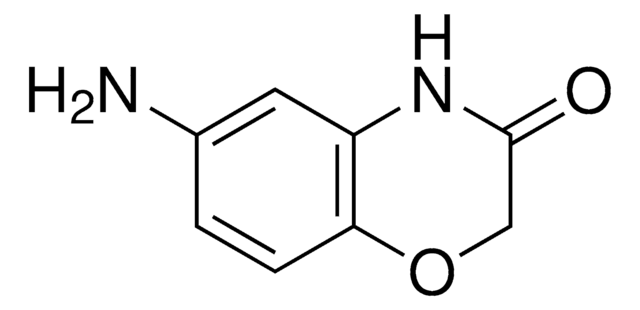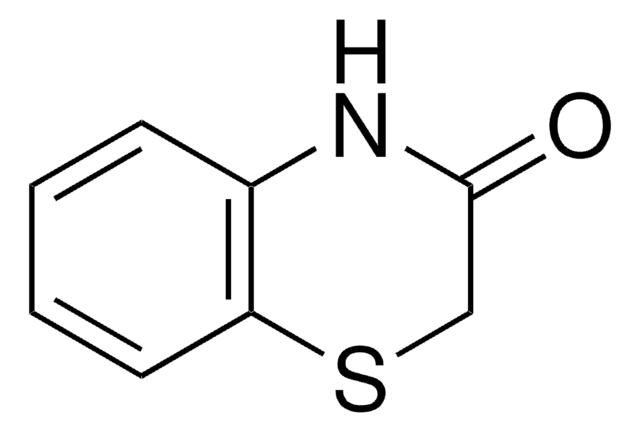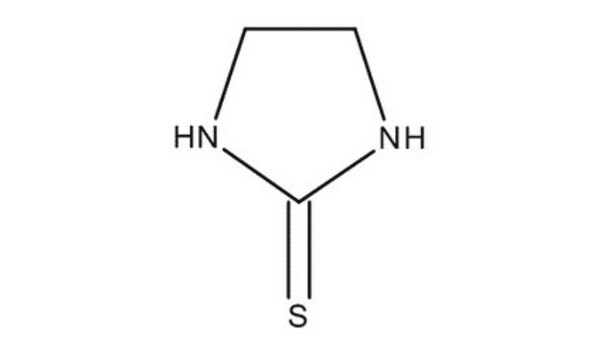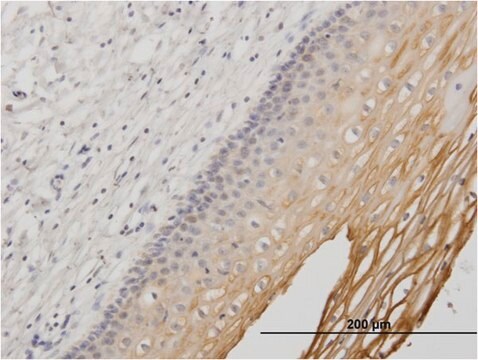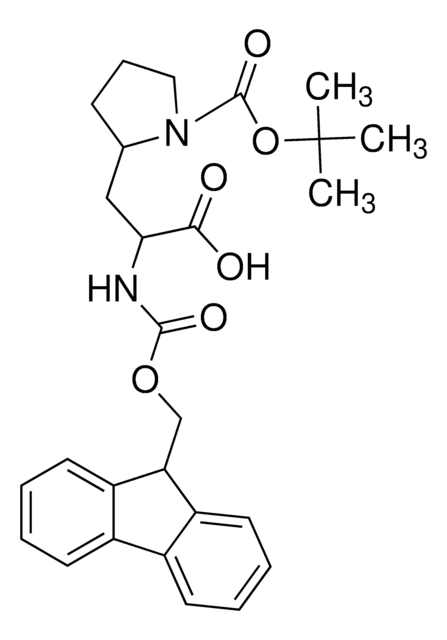CRM69083
Dinoseb
certified reference material, TraceCERT®, Manufactured by: Sigma-Aldrich Production GmbH, Switzerland
Sinônimo(s):
2-sec-Butyl-4,6-dinitrophenol
About This Item
Produtos recomendados
grau
certified reference material
TraceCERT®
Nível de qualidade
linha de produto
TraceCERT®
prazo de validade
limited shelf life, expiry date on the label
fabricante/nome comercial
Manufactured by: Sigma-Aldrich Production GmbH, Switzerland
formato
neat
temperatura de armazenamento
2-8°C
cadeia de caracteres SMILES
CCC(C)c1cc(cc(c1O)[N+]([O-])=O)[N+]([O-])=O
InChI
1S/C10H12N2O5/c1-3-6(2)8-4-7(11(14)15)5-9(10(8)13)12(16)17/h4-6,13H,3H2,1-2H3
chave InChI
OWZPCEFYPSAJFR-UHFFFAOYSA-N
Procurando produtos similares? Visita Guia de comparação de produtos
Categorias relacionadas
Descrição geral
Certified content by quantitative NMR incl. uncertainty and expiry date are given on the certificate.
Download your certificate at: http://www.sigma-aldrich.com
Dinoseb is a selective nitrophenolic herbicide used for protection against postemergence of grass and broad-leaf weeds in vegetables, fruits, nuts, and other field crops such as soybeans. In addition, it also finds its use as an insecticide for grapes, and as a seed drying agent. It acts by uncoupling oxidative phosphorylation in mitochondria and inhibiting ATP synthesis.
Under the Regulation (EC) No 1107/2009 and withdrawing the Council Directives 79/117/EEC and 91/414/EEC, dinoseb is not approved for its use as a plant protection product in the European Union (EU). It was also banned for use as a pesticide in the US in 1986 by the US EPA (Environmental Protection Agency). But a default maximum residue limit (MRL) in the range of 0.02 mg/kg to 0.1 mg/kg is set for the presence of dinoseb (measured as a sum of dinoseb, its salts, dinoseb-acetate, and binapacryl) in products of plant and animal origin.
Aplicação
The dinoseb CRM may also be used to:
- Simultaneously determine dinoseb and pendimethalin in surface water samples using optimized direct injection (DI) and solid phase extraction (SPE) coupled to ultra high-performance liquid chromatography-tandem mass spectrometry (UPLC-MS/MS)
- Evaluate anodic voltametric analysis of dinoseb in river water samples using a boron doped diamond electrode following cathode pre-treatment and in the presence of cationic surfactants
- Extract 15 phenols from refinery wastewater samples by dispersive liquid-liquid microextraction (DLLME) technique and identify them by liquid chromatography-photodiode array detector (LC-PDA)
- Detect chlorophenoxy acid methyl esters and other chlorinated herbicides in peppermint tea, plum, and orange peel extract soft ionization gas chromatography coupled to quadrupole time-of-flight mass spectrometry (GC-QTOFMS)
- Analyze 32 pesticide residues of four different chemical classes in tea brew and tea leaves samples by a sample treatment method based on metabolomics and liquid chromatography-mass spectrometry (LC-MS)
- Determine pendimethalin, dinoseb and sodium 5-nitroguaiacolate in vegetable samples by differential pulse voltammetry (DPV) and chemometrics
Produtos recomendados
Informações legais
Palavra indicadora
Danger
Frases de perigo
Declarações de precaução
Classificações de perigo
Acute Tox. 2 Oral - Acute Tox. 3 Dermal - Aquatic Acute 1 - Aquatic Chronic 1 - Eye Dam. 1 - Repr. 1B - Skin Irrit. 2 - Skin Sens. 1
Perigos de suplementos
Código de classe de armazenamento
6.1A - Combustible, acute toxic Cat. 1 and 2 / very toxic hazardous materials
Classe de risco de água (WGK)
WGK 3
Ponto de fulgor (°F)
306.9 °F - closed cup
Ponto de fulgor (°C)
152.7 °C - closed cup
Escolha uma das versões mais recentes:
Certificados de análise (COA)
Não está vendo a versão correta?
Se precisar de uma versão específica, você pode procurar um certificado específico pelo número do lote ou da remessa.
Já possui este produto?
Encontre a documentação dos produtos que você adquiriu recentemente na biblioteca de documentos.
Nossa equipe de cientistas tem experiência em todas as áreas de pesquisa, incluindo Life Sciences, ciência de materiais, síntese química, cromatografia, química analítica e muitas outras.
Entre em contato com a assistência técnica